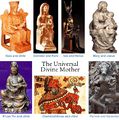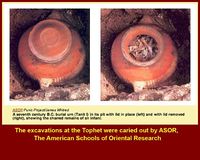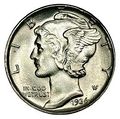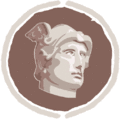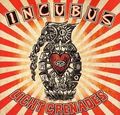Difference between revisions of "911:Occult symbolism VII"
(→Nimrod) |
(→Baal) |
||
| Line 162: | Line 162: | ||
** Belfast | ** Belfast | ||
** Baltic Sea? | ** Baltic Sea? | ||
** Beltain rites | |||
*** '''[[w:Fire Worship|Fire Worship]] | |||
**** '''The "Bel-Fire" or "Bel-tane" rites and games which still survive in many parts of the British Isles are generally recognized to be vestiges of a former widely prevalent worship of "Bel"''' in these islands, extending from [[w:St Michael's Mount|St. Michael's Mount]] in Cornwall to [[w:Shetland|Shetland]], '''which is now seen to have been introduced by the [[w:Phoenicians|Phoenicians]], and to be a survival of the great solar festival celebrations at the [[w:Summer solstice|Summer solstice]]. The name "Bel-tane" or "Bel-tine" means literally "Bel's Fire."''' {"Bel-tane" or "Bel-tine" is defined by old Scottish, Irish and Gaelic writers as "Fire of the god Bil or Bial or Bel." Thus the Irish king [[w:Cormac III of Munster|Cormac]] at the beginning of the tenth century A.D. describes "Bil-tene" as Lucky Fire, and defines Bil or Bial as "an idol god." (Cormac's Glossary, ed. Stokes, 19, 38); and Keating states "Bel-tainni is the same as Beil-teine, that is, teine Bheil or Bel's Fire." Its second element Tan in Breton and Tane, Tine or Tene, means "Fire" in Scottish and Irish Scottish with variant Teind or Tynd, "a spark of Fire " (J.S.D., 38, 564) and Eddic Gothic Tandr, "to light or kindle Fire," thus showing Gothic origin of English "Tinder." This Tan or Tene seems to be derived from the Akkadian Tenu for the Crossed Fire-producing sticks (M.D. 1176) with meaning also "to grind [firewood]," ib. The Breton form of the name for Bel-Fire of Tan-Heol is the same Tan (Fire) transposed + Heol, "the Sun" or Bil.} The rite of Bel-Fire now surviving in the British Isles is mostly a mere game performed by boys and young people on Midsummer eve in the remoter parts of the country. On a moor, a circle is cut on the turf sufficient to hold the company and a bonfire is lit inside, and torches are waved round the head (presumably in sunwise direction, see later) while dancing round the fire; after which the individuals leap through the flames or glowing embers. {Such a game was practised in the writer's boyhood in the West of Scotland. And Mr. S. Laing, the archaeologist, who was born in 1810, writes with reference to these Bel-Fires lighted on the highest hills of Orkney and Shetland. '''"As a boy, I have rushed with my playmates through the smoke of these bonfires without a suspicion that we were repeating the homage paid to Baal."''' (Human Origins, 1897, 161.)} [http://www.jrbooksonline.com/pob/pob_ch19.html] | |||
**** This is the festival of the fire God Bel. Bel has been worshipped under many names in all parts of the world for thousands of years; Bel, Beli, Balar, Balor, Belenus, Baal, and Belial. Traditionally, Beltane would be the night on which the old hearth fires were extinguished and the new were kindled from the Bel fire. These fires were placed on the top of hills and produced a chain of beacons which ran across the land. Cattle would be driven between the fires and '''people would leap over them to ensure fertility for the coming season'''. [http://www.deszone.net/beltane.html] | |||
*** '''[[w:Fertility rite|Fertility rites]] | |||
**** In times past, the [[911:Occult_symbolism_XII#Maypole|Maypole]] would be central to the Beltane celebrations - a tall pole surmounted by a circlet of flowers which would descend as the ribbons were wound tight by the dancers. This symbol of sexual union would be hard to mistake. Those who had not yet found a partner would seek one at the Beltane rites, wearing green to announce their intentions [http://www.deszone.net/beltane.html] | |||
Also see: | |||
* [[w:Ardentinny|Ardentinny]] | |||
==[[w:Moloch|Moloch]]== | ==[[w:Moloch|Moloch]]== | ||
Revision as of 11:16, 17 July 2010
Site menu:
- Occult symbolism Intro
- History of oppression
- Social terrorism
- Economic terrorism
- "There were giants in the earth in those days; and also after that, when the sons of God came in unto the daughters of men, and they bare children to them, the same became mighty men which were of old, men of renown." -- Genesis 6:4.
- "For all the gods of the Gentiles are devils: but the Lord made the heavens. " -- Psalm 96:5 (Douay-Rheims Bible)
- Occult symbolism pages:
- Introduction to symbolism
- Part I (Egyptian mythology, Pyramid, All-seeing eye, Obelisk)
- Part II (Astrology)
- Part III (Stars)
- Part IV (Cross, Rods, Awen, Thunderbolt, Bell, Shell)
- Part V (Occultism)
- Part VI (Circles, Infinity, Spirals)
- Part VII (Deities)
- Part VIII (Colors)
- Part IX (Alphabets)
- Part X (Animals, Insects, Arachnids)
- Part XI (Plants)
- Part XII (Life, Death, Sexuality)
- Part XIII (Alchemy)
- Part XIV (Masonic symbolism)
- Part XV (Masonic places)
- Part XVI (Hand signs)
- Part XVII (Occult Media Programming)
Gods
Solar deity
- Occult symbolism:Sun
- Solar calendar
- Solar diameter:History of observation
- List of solar deities
- Ra (Egyptian)
- Apollo (Greek and Roman mythology)
- Surya (Indian) [See also Sariel, His temple was called a Arasavalli ]
- Helios (Greek) [See Heliopolis ]
- Shamash (Akkadian name of the sun god) [See also : Shamsiel ]
- Shapash (Canaanite goddess of the sun)
- Utu (Sumerian mythology)
- Sol Invictus (also know as Unconquered Sun). This god is more closely associated with Saturn, as holiday (Dies Natalis Solis Invicti) was celebrated at the end of the year with a festival called the Saturnalia.
- Kinich Ahau (Maya sun god)
- Inti (Inca sun god)
- Svarog (Slavic mythology)
- Elagabalus (Syro-Roman sun god)
- Tonatiuh (Aztec mythology)
- Amaterasu (sun goddess and one of the principal Shinto deities)
- Huitzilopochtli (Aztec mythology)
- Lugh (Irish deity)
- Sól (sun) (Germanic mythology)
- Liza (Sun god to the Fon people of West Africa)
Lunar deity
- Occult symbolism:Moons
- Lunar calendar
- List of lunar deities
- Thoth (Egyptian)
- Khonsu (Egyptian)
- Sin (Mesopotamia)
- Máni (Norse mythology)
- Tsukuyomi-no-Mikoto (Japan)
- Rahko
- Tecciztecatl
- Arma (Hittite)
- Tanit (Phoenician lunar goddess)
- Mawu (Dahomey mythology)
- Selene (Greek mythology)
- Artemis (Greek and Roman mythology)
- Bendis (Thracian goddess)
- Diana (Roman mythology)
- Chang'e (Chinese goddess of the moon)
- Ix Chel (Maya moon goddess)
- Coyolxauhqui (Aztec mythology)
Deities
- Various notes:
Mother goddess

One of the most outstanding examples of how Babylonian paganism has continued to our day may be seen in the way the Romish church invented Mary worship to replace the ancient worship of the mother goddess.
The story of the mother and child was widely known in ancient Babylon and developed into an established worship. Numerous monuments of Babylon show the goddess mother Semiramis with her child Tammuz in her arms. When the people of Babylon were scattered to the various parts of the earth, they carried the worship of the divine mother and her child with them. This explains why many nations worshipped a mother and child in one form or another centuries before the true savior, Jesus Christ, was born into this world! In the various countries where this worship spread, the mother and child were called by different names, for, we will recall, language was confused at Babel.
The Chinese had a mother goddess called Shing Moo or the "Holy Mother." She is pictured with child in arms and rays of glory around her head.
The ancient Germans worshipped the virgin Hertha with child in arms. The Scandinavians called her Disa who was also pictured with a child. The Etruscans called her Nutria, and among the Druids the Virgo-Patitura was worshipped as the "Mother of God." In India, she was known as Indrani, who was also represented with child in arms.
The mother goddess was known as Aphodite or Ceres to the Greeks; Nana, to the Sumerians; and as Venus or Fortuna to her devotees in the olden days of Rome, and her child as Jupiter. At one time the mother and child were known as Devaki and Crishna. For ages, Isi, the "Great Goddess" and her child Iswara, have been worshipped in India where temples were erected for their worship.
In Asia, the mother was known as Cybele and the child as Deoius (Attis?). "But regardless of her name or place", says one writer, "she was the wife of Baal, the virgin queen of heaven, who born fruit although she never conceived." [7]
In Ephesus, the great mother was known as Diana. The temple dedicated to her in that city was one of the seven wonders of the ancient world! Not only at Ephesus, but throughout all Asia and the world was the goddess worshipped (Acts 19:27).
In Egypt, the mother was known as Isis and her child as Horus. It is very common for the religious monuments of Egypt to show the infant Horus seated on the lap of his mother.
This false worship, having spread from Babylon to the various nations, in different names and forms, finally became established at Rome and throughout the Roman Empire. Says a noted writer concerning this period: "The worship of the Great Mother (Queen of Heaven)...was ...very popular under the Roman Empire. Inscriptions prove that the two (the mother and the child) received divine honors ... not only in Italy and especially at Rome (Madonna), but also in the provinces, particularly in Africa, Spain, Portugal, France, Germany, and Bulgaria."
Hislop says that "Jesuit missionaries were astonished to find the counterpart of Madonna and her child as devoutly worshiped as in Papal Rome itself" [8]
See:
- Semiramis Queen of Babylon by Bryce Self
- Various notes:
1) Ankh Nes Meryre and Son Pepi. 2) Cyprus. 3)Madonna Guanyin, Goddess of mercy 4) Matrika from Tanesara of India 5) Yasoda and Krishna. 6) Mother and son 2000-1850 B.C. 7) Mexico, Jalisco 200 B.C.- 500 A.D. 8) Maya. 9) Mexico, Colima 200 B.C.- 500A.D. 10) Mykene, Greece 11) Sun Goddess, Arinna. 12) Virgin Mary
Universal mother goddess mythology.
Gaia, Demeter, Isis, Maria (Catholicism), Kuan Yin, Chalchiuhtlicue , Parvati (see also: Devi).Mother or Mary-worship is the most powerful and emotional phenomenon in the Roman Catholic Church today. This mystic cult is given credence by the multitude of accounts about supernatural phenomena involving statues, apparitions, and healings. Since Mary-worship is found nowhere in the writings of the first Christians, it is evident that its origin is found in the universal adoration of the mother goddess all throughout paganism before the time of Christ. It was adopted into the rising Roman Church early in its history - some suggest after the 4th century A.D. [1]
Nimrod
In Gen. 10:11, already quoted, we read that Nimrod built the city of Nineveh. This little item of Bible history enables us to identify Nimrod with the king Ninus of classical writings. The name Nineveh literally means “The habitation of Ninus.” The historian Apollodorus expressly states that “Ninus is Nimrod.” (Apollodori, Fragm. 68 in Willer, Vol. i, p. 440) In the ancient records of Justin and Diodorus Siculus, Ninus is credited with similar kingly powers as are attributed to Nimrod by the Scriptures. (Justin, Hist. Rom. Script., Vol. ii, p. 615; Diodorus, Bibliotheca, lib. ii, p. 63) Ninus was the son, as well as the husband, of Semiramis. According to Eusebius these two reigned as king and queen in the time of Abraham; but the great chronologist Clinton, and the celebrated Excavator and Linguist Layard, both assign an earlier date to the reign of Ninus and Semiramis. [9]
In one of the famous sculptures of ancient Babylon, Ninus and Semiramis are represented as actively engaged in the pursuits of the chase, the “quiver-bearing Semiramis” being a fit companion for the “mighty hunter before the Lord.” Diodorus, lib. ii, p. 69
- Genesis 10:8 & 1 Chronicles 1:10
- "And Cush begat Nimrod: he began to be a mighty one in the earth."
- Genesis 10:9
- "He was a mighty hunter before the LORD: wherefore it is said, Even as Nimrod the mighty hunter before the LORD."
- Micah 5:6
- "And they shall waste the land of Assyria with the sword, and the land of Nimrod in the entrances thereof: thus shall he deliver us from the Assyrian, when he cometh into our land, and when he treadeth within our borders."
- See also:
Baal
- "The Worship and the Service of the Baalim": part 1, part 2 part 3.
- The word Baal means "Lord of the Sun" (Thirty Thousand Gods Before Jehovah p 57)
- SUN-WORSHIP" & BEL-FIRE RITES IN EARLY BRITAIN DERIVED FROM THE PHOENICIANS
- Baal in the Bible
- People who worshipped Baal in the Bible
- Jezebel (1 Kings 16:31, 1 Kings 18:19)
- Ahab (2 Kings 3:1-3)
- The Israelite under the name of Baalberith after Gideon dies (Judges 8:32-33)
- People who worshipped Baal in the Bible
- Baal Worship and child sacrifices
- Also see:
- Amurru (Hittite name)
- Ba'al
- Hadad
- Baal-berith
- Beelzebub
- Bel, Bêl seems to be an epithet of the god Marduk [10] (see Jeremiah 50:2; Jeremiah 51:44, Isaiah 46:1)
- Belial
- Baalim
- Ba'al Pe'or
- Numbers 25:2,3 "They called the people unto the sacrifices of their gods: and the people did eat, and bowed down to their gods. And Israel joined himself unto Baalpeor: and the anger of the LORD was kindled against Israel."
- Balaam
- Baalti?
- From these two poems, and from the 2nd homily on Fasting (Bickell 14=Bedjan 17) we gain a vivid picture of the miseries borne by the inhabitants of that frontier region during the wars between Persia and the Romano-Greek empire. There are also instructive references to the heathen practices and the worship of pagan deities (such as Baalti, Uzzi, Gedlath and the planet Venus) prevalent in Mesopotamia. Two other poems (Bickell 35, 36=Bedjan 66, 67), written probably at Antioch, describe the prevalence of sorcery and the extraordinary influence possessed by Chaldeans and enchanters over women who were nominally Christians. (wikipedia)
- Todo Thirty Thousand Gods Before Jehovah p17?
- Belize?
- Belgium
- Baltimore
- Beltio
- Belfast
- Baltic Sea?
- Beltain rites
- Fire Worship
- The "Bel-Fire" or "Bel-tane" rites and games which still survive in many parts of the British Isles are generally recognized to be vestiges of a former widely prevalent worship of "Bel" in these islands, extending from St. Michael's Mount in Cornwall to Shetland, which is now seen to have been introduced by the Phoenicians, and to be a survival of the great solar festival celebrations at the Summer solstice. The name "Bel-tane" or "Bel-tine" means literally "Bel's Fire." {"Bel-tane" or "Bel-tine" is defined by old Scottish, Irish and Gaelic writers as "Fire of the god Bil or Bial or Bel." Thus the Irish king Cormac at the beginning of the tenth century A.D. describes "Bil-tene" as Lucky Fire, and defines Bil or Bial as "an idol god." (Cormac's Glossary, ed. Stokes, 19, 38); and Keating states "Bel-tainni is the same as Beil-teine, that is, teine Bheil or Bel's Fire." Its second element Tan in Breton and Tane, Tine or Tene, means "Fire" in Scottish and Irish Scottish with variant Teind or Tynd, "a spark of Fire " (J.S.D., 38, 564) and Eddic Gothic Tandr, "to light or kindle Fire," thus showing Gothic origin of English "Tinder." This Tan or Tene seems to be derived from the Akkadian Tenu for the Crossed Fire-producing sticks (M.D. 1176) with meaning also "to grind [firewood]," ib. The Breton form of the name for Bel-Fire of Tan-Heol is the same Tan (Fire) transposed + Heol, "the Sun" or Bil.} The rite of Bel-Fire now surviving in the British Isles is mostly a mere game performed by boys and young people on Midsummer eve in the remoter parts of the country. On a moor, a circle is cut on the turf sufficient to hold the company and a bonfire is lit inside, and torches are waved round the head (presumably in sunwise direction, see later) while dancing round the fire; after which the individuals leap through the flames or glowing embers. {Such a game was practised in the writer's boyhood in the West of Scotland. And Mr. S. Laing, the archaeologist, who was born in 1810, writes with reference to these Bel-Fires lighted on the highest hills of Orkney and Shetland. "As a boy, I have rushed with my playmates through the smoke of these bonfires without a suspicion that we were repeating the homage paid to Baal." (Human Origins, 1897, 161.)} [11]
- This is the festival of the fire God Bel. Bel has been worshipped under many names in all parts of the world for thousands of years; Bel, Beli, Balar, Balor, Belenus, Baal, and Belial. Traditionally, Beltane would be the night on which the old hearth fires were extinguished and the new were kindled from the Bel fire. These fires were placed on the top of hills and produced a chain of beacons which ran across the land. Cattle would be driven between the fires and people would leap over them to ensure fertility for the coming season. [12]
- Fertility rites
- In times past, the Maypole would be central to the Beltane celebrations - a tall pole surmounted by a circlet of flowers which would descend as the ribbons were wound tight by the dancers. This symbol of sexual union would be hard to mistake. Those who had not yet found a partner would seek one at the Beltane rites, wearing green to announce their intentions [13]
- Fire Worship
Also see:
Moloch

- Also see
- Occult symbolism:Bull
- Other names in the bible:
- Molech
- Milcom (Ammonites) 1 Kings 11:33
- Moloch
- Chemosh (Moabites) 1 Kings 11:33
- Malik (Also see: Melek Taus)
- Mlk
- Moloch the God Baal, the Bull of the Sun, was widely worshipped in the ancient Near East and wherever Carthaginian culture extended. Baal Moloch was conceived under the form of a calf or an ox or depicted as a man with the head of a bull.
- Moloch has been identified with Milcom, with the Tyrian god Melqart, with the Carthaginian Ba‘al Hammon to whom children were purportedly sacrificed, with the Assyrian/Babylonian Malik, and at Palmyra Malach-bel and with any other god called 'Lord' (Ba‘al) or (Bel), the sun god of the Ammonites in old Palestine and the Sumerian Baal. These various suggested equations combined with the popular solar theory hypotheses of the day generated a single theoretical sun god Baal.[14]
The name Moloch
- 'Hadad', 'Baal' or simply 'the King' identified the god within his cult. The name Moloch is not the name he was known by among his worshippers, but a Hebrew translation. The written form Moloch (in the Septuagint Greek translation of the Old Testament), or Molech (Hebrew), is specifically Melech or ‘king’, tranformed by reading it with the vowels of bosheth or ‘shameful thing’. In a similar way Beelzebub was transformed by vowel substitutions into the Lord of the Flies. He is sometimes also called Milcom in the Old Testament.
Moloch cult
- Among the rituals in the worship of Moloch was the 'taking up of the tabernacle' of Moloch, in which the god's image, under a portable canopy, was paraded. This was a widespread practice, in Babylon and elsewhere, wherever the spirit of a god was felt to reside in the deity's image or idol. It was also customary to consecrate chariots and horses to Moloch.
Child sacrifice
- Religious infanticide historically was widespread among the peoples of the Eastern Mediterranean region, but in the cult of Moloch is the best known. In many instances the bodies of children were burnt as sacrifices.
- Psalm 106:37-38
- "Yea, they sacrificed their sons and their daughters unto devils, And shed innocent blood, even the blood of their sons and of their daughters, whom they sacrificed unto the idols of Canaan: and the land was polluted with blood."
- Psalm 106:37-38
- In the kingdom of Judah, children were wont to be sacrificed to Moloch in a valley of the sons of Hinnom, which received also the name of the Valley of Tophet.
- A detailed, late description of Moloch's image says that it was hollow, and was provided with seven receptacles, in which were deposited the different offerings of the worshippers. Into the first was put an offering of fine flour; in the second an offering of turtle doves; into the third a sheep; into the fourth a ram; into the fifth a calf; into the sixth an ox; and into the seventh a child, which was consumed in the image. (It is because of this, Moloch is associated with Mithras and his seven mysterious gates with seven chambers)
- Talmudic tradition asserts the image of Moloch to have been made of brass, and to have been represented sitting on a brazen throne, adorned with a royal crown, having the head of a calf, and his arms extended to receive his youthful victims.
- According to Classical Greek and Roman accounts: Later commentators have compared these accounts with similar ones from Greek and Latin sources speaking of the offering of children by fire as sacrifices in the Punic city of Carthage, which was a Phoenician colony. Cleitarchus, Diodorus Siculus and Plutarch all mention burning of children as an offering to Cronus or Saturn, that is to Ba‘al Hammon, the chief god of Carthage.
Paul G. Mosca, in his thesis described below, translates Cleitarchus' paraphrase of a scholia to Plato's Republic as:
There stands in their midst a bronze statue of Kronos, its hands extended over a bronze brazier, the flames of which engulf the child. When the flames fall upon the body, the limbs contract and the open mouth seems almost to be laughing until the contracted body slips quietly into the brazier. Thus it is that the 'grin' is known as 'sardonic laughter,' since they die laughing.
Diodorus Siculus (20.14) wrote:
There was in their city a bronze image of Cronus extending its hands, palms up and sloping toward the ground, so that each of the children when placed thereon rolled down and fell into a sort of gaping pit filled with fire.
Diodorus also relates that relatives were forbidden to weep and that when Agathocles defeated Carthage, the Carthaginian nobles believed they had displeased the gods by substituting low-born children for their own children. They attempted to make amends by sacrificing 200 children of the best families at once, and in their enthusiasm actually sacrificed 300 children.
Plutarch wrote in De Superstitiones 171:
... the whole area before the statue was filled with a loud noise of flutes and drums so that the cries of wailing should not reach the ears of the people.
Extent of the Moloch cult
- The god Baal variously named, sometimes with combined forms, was widely worshipped in the ancient near east.
- The Phoenicians of Tyre extended the worship of Baal/Moloch in the particular Tyrian manifestation Baal Melkart, ('the Baal (king) of the city') to Phoenician colonies around the Mediterranean, the greatest of which was Carthage in North Africa.
- Moloch was worshiped among the Sepharvites as Adrammelech and Anammelech, and by the Moabites and Ammonites.
- In Minoan Crete, the Minotaur, the monstrous bull-headed creature at the center of the Labyrinth that consumed sacrificed youths, and which was overcome by Theseus, should perhaps be connected with Moloch.
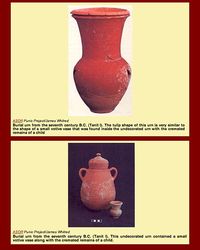
- Moloch, 'the king' was even worshiped by the Hebrews, until the destruction of all the idols by Josiah in 622/21 BCE. Solomon built an altar to Molech (1 Kings 11:7), and Manasseh sacrificed his son, by making him “pass through the fire,” as did King Ahaz. Not every combined form of melech ('king') in a name links an individual with Moloch, however (cf Abimelech).
- The strenuous energy that had to be put into the interdiction of child sacrifice that had been practiced among the earliest Israelites is reflected in the episode of Abraham and Isaac in the Book of Genesis. The gruesome rites associated with Moloch are again expressly forbidden under pain of death in
- Leviticus 20:2
- “Again, thou shalt say to the children of Israel, whosoever he be of the children of Israel, or of the strangers that sojourn in Israel, that giveth any of his seed unto Moloch, he shall surely be put to death: the people of the land shall stone him with stones.”
- Leviticus 20:2
- In various other passages of the Law of Moses, the Israelites were forbidden to dedicate their children to Moloch, by causing them to “pass through the fire”, an expression the precise meaning of which is mooted by scholars.
- It is plain from various passages of the prophets, that the sacrifices of children among the Jews before captivity, which are commonly known as sacrifices to Moloch, were not presented at the temple, but consumed outside the city at Tophet in the ravine below the temple.
- Jeremiah 7:31,
- “And they have built the high places of Tophet, which is in the valley of the son of Hinnom, to burn their sons and daughters in the fire; which I commanded them not, neither came it into my heart.”
- And Jeremiah 19:5,
- “They have built also the high places of Baal, to burn their sons with fire for burnt offerings to Baal, which I commanded them not, nor spake it, neither came it into my mind.”
- Jeremiah 7:31,
- From Isaiah it appears that Tophet means a pyre, such as is prepared for a king. Later, however, the name Tophet was construed to refer to the sounds of the drums and cymbals that accompanied the sacrifice of children. Compare the role of the Korybantes in Crete, shaking their spears and clashing their shields, drowning out the cries of the infant Zeus when his cannibal father sought him out, aiming to consume him— like a Moloch. [15]
The Mesha Stele, popularized in the 19th century as the Moabite Stone, is a black basalt stone, bearing an inscription by the 9th century BC Moabite King Mesha that constitutes one of the most important direct accounts of the history of the Biblical world. The inscription of 34 lines, the most extensive inscription ever recovered from ancient Israel, was written in Paleo-Hebrew alphabet. It was set up by Mesha, about 850 BC, as a record and memorial of his victories in his revolt against the Kingdom of Israel, which he undertook after the death of his overlord, Ahab. [2]
Tammuz
(todo)
- Ezekiel 8:14 "Then he brought me to the door of the gate of the LORD's house which was toward the north; and, behold, there sat women weeping for Tammuz."
- Tammuz (Hebrew month)
Adonis
- From a book entitled, Dictionary of Ancient Deities, we find that Adonis, Adon, Adonai, and Adonay are all the same which mean “lord”; and in the Old Testament, the word Adonai is subsituted for the Hebrew tetragram, YHWH! The gods Tammuz (Adonis) and Osiris were associated with fertility and both were killed by boars (swine)!
Astarte
(todo)
Dagon
Cybele
Saturn
See: Saturn Occult symbolism: Planet: Saturn
Hermes
- Various notes:
- Hermes is one of the twelve Olympian gods (the "Dodekatheon"), which were the principal gods of the Greek pantheon, residing atop Mount Olympus. Hermes was the god of boundaries and of the travelers who cross them, of shepherds and cowherds, of thieves and road travelers, of orators and wit, of literature and poets, of athletics, of weights and measures, of invention, of general commerce, and of the imagineing of thieves and liars. His symbols include the tortoise (patience/time/wisdom?), the rooster (sun symbolism/primordial intellect), the winged sandals (spiritual/enlightenment), and the caduceus (priesthood magic). The analogous Roman deity is Mercury. [16] (adapted)
- In Etruscan mythology, Turms was the equivalent of Greek Hermes, god of trade and the messenger god between people and gods.
- In Roman mythology, Mercury was a messenger, and a god of trade, profit and commerce, the son of Maia Maiestas and Jupiter. His name is related to the Latin word merx ("merchandise"; compare merchant, commerce, etc.).
- See also:
- Non-logo's:
Mercury Dime (1916–1945)
The head of Hermes / Mercury appeared on the front side of all US dimes during this period.
- Logo's:
Totus Tuus - a medical management company.
Note: Totus Tuss was Pope John Paul II's apostolic motto. It means "totally yours" and expressed his strong Marian devotion.Hannover Messe
(Est. 1947)
This is the world's largest industrial technology fair, held each year in Hannover, Germany.First passenger service logo featured Mercury, the Roman god of travel and commerce. The triangle represents the "D" of the Greek alphabet, which is "Delta." Logo circa 1929
(Now Delta Airlines)Hermes Groep (bus public transport company)
Mercury automobile logo (owned by the Ford Motor Company)
Mars
Venus
- Various notes:
- Alternative names: "Eastern Star", "Morning Star"
- "Other goddesses linked to Venus Mythology
"The Birth of Venus" a painting by Sandro Botticelli from around 1482.
Prometheus
- Various notes:
- See also: Prometheus Bound
- This statue depicts Prometheus, a Titan of Greek mythology known for his great intelligence. He has however betrayed the god Zeus by stealing fire and giving it to mankind. He therefore credited to have taught mankind the arts of civilization such as writing, mathematics, agriculture, medicine, and science. Zeus then punished Prometheus for his crime by having him bound to a rock while a great eagle ate his liver every day only to have it grow back to be eaten again the next day.[17]
Prometheus statue at the Rockefeller Center. Behind the statue is an inscription saying: “Prometheus, teacher in every art, brought the fire that hath proved to mortals a means to mighty ends.”
Note: The ring with the 12 signs of the Zodiac
Pan
- Various notes:
- Min (god). This egyptian god Min was a fertility dark-skinned god depicted with an erected penis and a flail. Also know as Khem or Min, he was the god of reproduction; as Khnum, he was the creator of all things, "the maker of gods and men". His cult was strongest in Coptos and Akhmim (Panopolis). As the central deity of fertility and possibly orgiastic rites Min became identified by the Greeks with the god Pan. (Wikipedia)
- Saturn Worship: “Pan was a composite creature, the upper part–with the exception of his horns–being human, and the lower part in the form of a goat. (…)The pipes of Pan signify the natural harmony of the spheres, and the god himself is a symbol of Saturn because this planet is enthroned in Capricorn, whose emblem is a goat” -Manly P. Hall, Secret of the ages
- Pan (Greek Πάν, genitive Πανός) is the Greek god of shepherds and flocks, of mountain wilds, hunting and rustic music: paein means to pasture. He has the hindquarters, legs, and horns of a goat, in the same manner as a faun or satyr. He is recognized as the god of fields, groves, and wooded glens; because of this, Pan is connected to fertility and season of spring.
- Pan's ancient Roman equivalent was Faunus, and they were both horned god deities. For this reason he is popular among many Neopagans and occultic groups.
- "It is likely that the demonized images of the incubus and even the horns and cloven hooves of Satan, as depicted in much medieval and post-medieval Christian literature and art, were taken from the images of Pan." [18]
See also:
The Death of Pan
Painting by the French painter Nicolas Poussin (1594-1665).
- Pan in popular culture:
Pans Labyrinth, a 2006 Spanish language fantasy film.
Known mason Walt Disney's Peter Pan
Demons
See also:
Lucifer
- Where did Satan Come from ?
- video: Luciferian Initiation (Start at 42:30) by Bill Schnoebelen
- (todo) According to Bill Schnoebelen in his Luciferian Initiation, Lucifer is a Cherubim, out of the 5 angels carrying the throne of God, he was the one on top of God
- Main attributes: Calf, Serpent/eagle, lion, and human (look up verses for each ref, ex he walks as a roaring lion seeking whom he may devour)
- The Babylonian Zodiac (MUL.APIN) is a worshipping system of Lucifer. His main 4 attributes being
Christ in Majesty shown within a vesica pisces shape in this medieval illuminated manuscript Mandorla? No, this pagan Christ has the 4 attributes of Lucifer: The calf (bottom right), The Lion (bottom left), the eagle/phoenix (top right) and the man with wings, the fallen angel (top left).
- See also
- Black Magic
- Occult etymology:Merkaba
Luciferianism
- “The Jesuit General, and the other high Jesuit Generals, they are sorcerers. They are Luciferians, and they worship what they would call Lucifer. They do not believe in Satan. They believe in Lucifer.” The Black Pope: Interview of Eric Jon Phelps VaticanAssassins.com
- video: Luciferian Initiation (Start at 42:30)
- "The Apocalypse is, to those who receive the nineteenth Degree, the Apotheosis of that Sublime Faith which aspires to God alone, and despises all the pomps and works of Lucifer. LUCIFER, the Light-bearer! Strange and mysterious name to give to the Spirit of Darkness! Lucifer, the Son of the Morning! Is it he who bears the Light, and with its splendors intolerable blinds feeble, sensual, or selfish Souls? Doubt it not! for traditions are full of Divine Revelations and Inspirations: and Inspiration is not of one Age nor of one Creed. Plato and Philo, also, were inspired." Albert Pike, Morals and Dogma of the Ancient and Accepted Scottish Rite of Freemasonry, p. 321 , 19th Degree of Grand Pontiff.
- "The day has come when Fellow Craftsman must know and apply their knowledge. The lost key to their grade is the mastery of emotion , which places the energy of the universe at their disposal. Man can only expect to be entrusted with great power by proving his ability to use it constructively and selflessly. When the Mason learns that the key to the warrior on the block is the proper application of the dynamo of living power, he has learned the mystery of his Craft. The seething energies of LUCIFER are in his hands, and before he may step onward and upward, he must prove his ability to properly apply energy. He must follow in the footsteps of his forefather, TUBAL-CAIN, who with the mighty strength of the war god hammered his sword into a plowshare." (Manly P. Hall, 33rd Degree, K.T., The Lost Keys of Freemasonry or The Secret of Hiram Abiff p. 48) , Forward by Reynold E. Blight, 33rd Degree, K.T., Illustrations by J. Augustus Knapp, 32nd Degree, Macoy Publishing and Masonic Supply Company, Inc., Richmond, Virginia"
- "I hereby promise the Great Spirit Lucifuge, Prince of Demons, that each year I will bring unto him a human soul to do with as as it may please him, and in return Lucifuge promises to bestow upon me the treasures of the earth and fulfill my every desire for the length of my natural life. If I fail to bring him each year the offering specified above, then my own soul shall be forfeit to him. Signed..... { Invocant signs pact with his own blood } " 'The Secret Teaching Of All Ages' by Manly Palmer Hall 33° p. 104
- "What is more absurd and more impious than to attribute the name of Lucifer to the devil, that is, to personified evil. The intellectual Lucifer is the spirit of intelligence and love; it is the paraclete, it is the Holy Spirit, while the physical Lucifer is the great agent of universal magnetism." [The Mysteries Of Magic' page-428.]
She wrote occult classics entitled "The Secret Doctrine" and "Isis Unveiled" which state:
- "It is Satan who is the God of our planet and the only God. Lucifer represents... Life... Thought... Progress... Civilization... Liberty... Independance... Lucifer is the Logos...the Serpent, the Savior". on pages 171, 225, 255 (Volume II). [19]
- "One of the most hidden secrets involves the so-called fall of Angels. Satan and his rebellious host will thus prove to have become the direct Saviours and Creators of divine man. Thus Satan, once he ceases to be viewed in the superstitious spirit of the church, grows into the grandiose image. It is Satan who is the God of our planet and the only God. Satan (or Lucifer) represents the Centrifugal Energy of the Universe, this ever-living symbol of self-sacrifice for the intellectual independence of humanity." pages 215, 216, 220, 245, 255, 533, (VI) [20] [21]
- "The Celestial Virgin which thus becomes the Mother of Gods and Devils at one and the same time; for she is the ever-loving beneficent Deity...but in antiquity and reality Lucifer or Luciferius is the name. Lucifer is divine and terrestial Light, 'the Holy Ghost' and "Satan' at one and the same time." page 539 (Volume?)[22]
- "Lucifer is divine and terrestrial light, the “Holy Ghost” and “Satan,” at one and the same time, visible Space being truly filled with the differentiated Breath invisibly; and the Astral Light, the manifested effects of the two who are one, guided and attracted by ourselves, is the Karma of humanity, both a personal and impersonal entity: personal, because it is the mystic name given by St. Martin to the Host of divine Creators, guides and rulers of this planet; impersonal, as the Cause and effect of universal Life and Death." [23]
- David Spangler (See also United Nations NewAge members)
- "Lucifer prepares man in all ways for the experience of Christhood and the Christ prepares man for the experience of God. But the light that reveals to us the presence of the Christ comes from Lucifer . He is the light giver. He is aptly named the Morning Star because it is his light that heralds for man the dawn of a greater consciousness. He is present when that dawn is realized ... Christ is the same force as Lucifer, but moving in seemingly the opposite direction'".(Dr. Burns, quoting David Spangler, "Finding Heaven On Earth", New Age Journal, January/February 1988, Vol. 4, Issue 1, reprinted in "Masonic And Occult Symbols Illustrated", p. 188).[24]
Spangler understands the deeper meanings of occult initiation. In the Reflections on the Christ, he explains that Lucifer is the "great initiator." Amazingly, he calls for a literal Luciferic initiation as a means of propelling mankind into the evolutionary New Age:
- "Lucifer comes to give to us the final gift of wholeness. If we accept it then he is free and we are free. This is the Luciferic initiation. It is one that many people now, and in the days ahead, will be facing, for it is an initiation in the New Age." (Reflections on the Christ, p. 45)[25]
David Spangler, who is very closely connected with and allied to this project (Planetary Initiative For The World We Choose, has defined the initiation in his book Reflections on the Christ as being “Luciferic.” This is probably the most honest statement that anyone inside the project has ever made! [26]
- All who wish to enter the New Age must undergo an "energy activation" or "rebirth", usually marked by a subjective trance-induced "light experience" where one meets either a "spirit guide" or one's "higher self" (no difference since all is one). The resulting "altered state of consciousness" will eventually lead to a "Luciferic initiation" into the "new humanity", or a submission to Lucifer as the leading divinity representing the Logos. This event is anticipated and discussed by many New Age leaders.
David Spangler, Lorian Association, Reflections on the Christ, Findhorn Publications p. 40, 44-45, Interconnections
- “Christ is the same force as Lucifer but moving in seemingly the opposite direction. Lucifer moves in to create the light within through the pressure of experience. Christ moves to release that light, that wisdom, that love into creation... Lucifer, like Christ, stands at the door of man’s consciousness and knocks. If man says, ‘Go away because I do not like what you represent. I am afraid of you,’ Lucifer will play tricks on that fellow. If man says, ‘Come in, and I will give to you the treat of my love and understanding and I will uplift you in the light and presences of the Christ, my outflow,’ then Lucifer becomes something else again. He becomes the being who carries that great treat, the ultimate treat, the light of wisdom. [Lucifer] is the light giver. … He stands no longer as the tester or the tempter but as the great initiator, the one who hands the soul over to the Christ and from the Christ on into even greater realms. … Lucifer works within each of us to bring us to wholeness, and as we move into a New Age, which is the age of man’s wholeness, each of us in some way is brought to that point which I term the Luciferic initiation, the particular doorway through which the individual must pass if he is to come fully into the presence of his light and his wholeness. … At some point each of us faces the presence of Lucifer. We either fear it when we come to grips with what we term ancient evil or the spirit of darkness, or we move throughit and realize that we are each of us light and dark. … When we do accept it, we can emerge into the radiance of our inner light, the light that can never be extinguished. … Lucifer comes to give to us the final gift of wholeness. If we accept it then he is free and we are free. That is the Luciferic initiation. It is one that many people now, and in the days ahead, will be facing, for it is an initiation in the New Age. … In the New Age consciousness there is not good and evil.”
- Various Notes
- “A generation would soon be born that had never known a world without Lucifer.” - Arthur C. Clarke [27]
- video: Secrets of Lucifer
- What is a Gnostic Luciferian?
Incubus
- Various notes:
- In Western medieval legend, an incubus (plural incubi) is a demon in male form supposed to lie upon sleepers, especially women, in order to have sexual intercourse with them. It was believed to do this in order to spawn other incubi. The incubus drains energy from the woman on whom it performs sexual intercourse in order to sustain itself,
(1991– 2008, now on hiatus)
Incubus, a Grammy-nominated alternative rock band from Calabasas, California.2007 album Light Grenades, by Incubus
Succubus
- Various notes:
Lilith
- Various notes:
- Alternative names: Lilitu, Lilit
- Mythological female Mesopotamian storm demon associated with wind and was thought to be a bearer of disease, illness, and death.
- First appeared in a class of wind and storm demons or spirits as Lilitu, in Sumer, circa 4000 BC.
(c. 1892)
Lilith, a painting by British writer and painter John Collier.In this live concert, was Britney Spears being portrayed as Lilith?
Links
Books
 Thirty Thousand Gods Before Jehovah ISBN 978-1885395931
Thirty Thousand Gods Before Jehovah ISBN 978-1885395931

